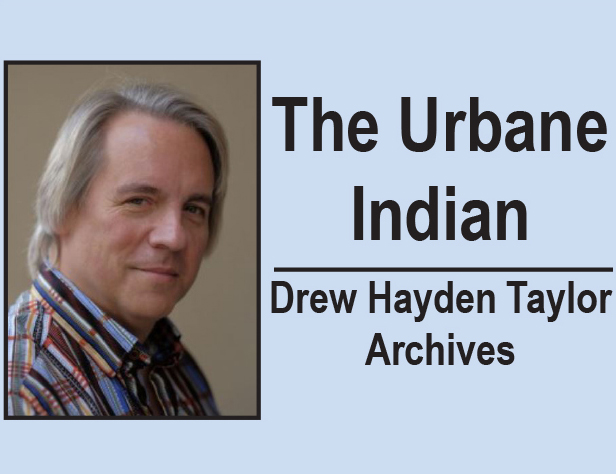
By Drew Hayden Taylor
Originally published in June 2011
Over the years, as a documenter of Aboriginal experiences, I have either come across or originated some useful and colorful acronyms that, at best, illustrate the complex First Nations world, or at worst, they muddy up the water and make working in the Native community a little more complicated. So I will let you decide. They are handy to know, and hopefully useful. If you have the opportunity, feel free to use as necessary.
And it should be noted, these are great for texting!
A.A.A.: Aboriginal Ancestry Assessor. Refers to people (usually Native) who arbitrarily decide how Native they think you or somebody actually is, as judged by their own unique and subjective standards. Also known as ‘A Cubed.’
B.I.O.C.: Big Indian On Campus. This is a college or university student who makes waves and/or draws attention. More of an attitude, than an academic position. Can be a force for good or evil depending on application.
C.H.I.P.: Cool Hip Indigenous People. Originally a T-shirt line, but now can refer to any First Nations people who ride the waves of fashion and style. But you must be able to tell the difference between your Manitoba Mukluks and your Dorothy Grant apparel.
D.I.A.: Department of Indian Affairs. This is the federal organization set up to administer to the needs of Canada’s Aboriginal population. It can also stand for “Don’t Involve Aboriginals” or “Do Indians Agree?” Also, this is the code name for an escort service for people wanting intimate relations with First Nations people. But don’t tell anyone.
I.W.A.B.A.: Indians With A Bad Attitude. Stereotypically somber and violent film character frequently seen in movies like Predator, Fargo or Clearcut. Also see Band council member.
K.F.J.: Kentucky Fried Jesuit. This is an ancient Mohawk recipe I came across. You can also have it extra crispy. Comes wrapped in a black robe.
N.A.D.: National Aboriginal Day. This is a 24-hour period in which to celebrate several tens of thousands of years of existence. Can be used as “a kick in the NADS.”
N.A.F.N.I.P.: Native Aboriginal First Nations Indigenous Person. In this age of political correctness, this is a collective term I coined to answer the annoying question “What do you people call yourselves? What is the correct term I should use for you people?” This should please everybody, except the Metis and Inuit.
P.E.T.A.: People who Eat Tasty Animals. This is not to be confused with People for the Ethical Treatment of Animals. They have substantially different mandates, and banquets.
P.M.S.: People of Mixed Societies. This is for those whose family tree have roots in many different countries, i.e. those who can eat white, brown, basmati and/or wild rice. Can also use the term MBA (Mixed Blood Associate) as in “I have an MBA.”
P.O.P: People Of Pallor. This can be used for those whose background can be traced back to Europe. Also, the vast majority of people in Canadian politics. And albinos.
P.T.B.: Powers That Be. Those who make decisions that involve us but over which we have little control or influence, like when the Band Council evicts you from your home on the Reserve (see column from two months ago). P.T.B.s can frequently be seen in the company of P.O.P.s.
S.A.M.: Survivors of Aboriginal Men. Women who have dated Native men with less than successful results, and live to grumble.
S.A.W.: Survivors of Aboriginal Women. Men who have dated Native women also with less than successful results, and live to grumble. Acronyms know no gender.
S.C.A.: Spousal Cultural Appropriation. Non-Native people who miraculously become as Native, if not more Native, than their partner as the years go by. Can also refer to Native people who date/marry non-Natives with the same result. The status card has no place in the bedrooms of the nation.
U.D.A.D.: Urban Dwellers of Aboriginal Descent. This should be self-explanatory, but not to be confused with the movie C.H.U.D. (Cannibalistic Human Underground Dwellers).
Y.U.P.N.I.: Young Urban Professional Native Indians. These are successful city people whose idea of roughing it consists of ordering the house wine.
It’s been said a picture is worth a thousand words, usually by photographers to writers. So I wonder, how many acronyms is a picture worth?
That is this month’s philosophical question.
